Water Temperature Changes Related to Strong Earthquakes: The Case of the Jinjia Well, Southwest China
Abstract
:1. Introduction
2. Observational Background
3. Water Temperature Changes
3.1. Standard Deviation of Normal Water Temperature Changes
3.2. Coseismic Water Temperature Changes
3.3. Preseismic Water Temperature Changes
4. Analysis of Preseismic Water Temperature Changes Using the Molchan Error Diagram
5. Discussion
5.1. Characteristics of Water Temperature Changes before Earthquakes
5.2. Influence of Sensor Location on Water Temperature
5.3. Mechanism of Water Temperature Anomalies
6. Conclusions
- (1)
- After abnormal changes in water temperature, moderate to strong earthquakes occurred in the surrounding region. The preseismic change of the Jinjia well is rising-recovery (rising to a high value and continuing for a period of time before decreasing or quickly recovering), with an amplitude range of 0.007–0.07 °C. The maximum change (0.07 °C) occurred before the largest earthquake, which was the M7.9 Wenchuan earthquake in 2008. The abnormal duration is 34–242 days.
- (2)
- Using the Molchan error diagram, the optimum threshold is 16.9533 °C, and the most likely time for an earthquake to occur is within approximately 4 months after the water temperature exceeds the threshold.
- (3)
- When the temperature sensor was installed at 130 m depth, the ratio of coseismic and preseismic changes for the earthquakes with seismic energy density above 10−3 J·m−3 was higher than that of the sensor at 135 m. The shorter the distance between the sensor and the fault, the higher the probability of water temperature changes related to earthquakes.
Author Contributions
Funding
Data Availability Statement
Acknowledgments
Conflicts of Interest
References
- Nakamura, Y.; Wakita, H. Precise temperature measurement of groundwater for earthquake-prediction study. Pure Appl. Geophys. 1984, 122, 164–174. [Google Scholar] [CrossRef]
- Shimamura, H.; Ino, M.; Hikawa, H.; Iwasaki, T. Groundwater microtemperature in earthquake regions. Pure Appl. Geophys. 1984, 122, 933–936. [Google Scholar] [CrossRef]
- Fu, Z.Z. The observation and earth-thermal precursor. In Thesis on Geological Tectonic and Stress in Earth Crust (1); Seismological Press: Beijing, China, 1988; pp. 1–8. (In Chinese) [Google Scholar]
- Mogi, K.; Mochizuki, H.; Kurokawa, Y. Temperature changes in an artesian spring at Usami in the Izu Peninsula (Japan) and their relation to earthquakes. Tectonophysics 1989, 159, 95–108. [Google Scholar] [CrossRef]
- Shi, Y.; Cao, J.; Ma, L.; Yin, B.J. Teleseismic coseis mic well temperature changes and their interpretation. Acta Seismol. Sin. 2007, 29, 265–273. [Google Scholar]
- Orihara, Y.; Kamogawa, M.; Nagao, T. Preseismic Changes of the Level and Temperature of Confined Groundwater related to the 2011 Tohoku Earthquake. Sci. Rep. 2014, 4, 6907. [Google Scholar] [CrossRef] [PubMed] [Green Version]
- Cox, S.C.; Menzies, C.D.; Sutherland, R.; Denys, P.H.; Chamberlain, C.; Teagle, D.A.H. Changes in hot spring temperature and hydrogeology of the Alpine Fault hanging wall, New Zealand, induced by distal South Island earthquakes. Geofluids 2015, 15, 216–239. [Google Scholar] [CrossRef] [Green Version]
- Sun, X.; Xiang, Y.; Shi, Z.; Wang, B. Preseismic Changes of Water Temperature in the Yushu Well, Western China. Pure Appl. Geophys. 2018, 175, 2445–2458. [Google Scholar] [CrossRef]
- Chien, S.J.; Chi, W.; Ke, C. Precursory and coseismic groundwater temperature perturbation: An example from Taiwan. J. Hydrol. 2020, 582, 124457. [Google Scholar] [CrossRef]
- He, A.; Singh, R.P. Coseismic Groundwater Temperature Response Associated with the Wenchuan Earthquake. Pure Appl. Geophys. 2020, 177, 109–120. [Google Scholar] [CrossRef]
- Yan, R. Study on the Characteristics and Mechanism of Hydrological Changes at Banglazhang Hot Spring Site in Longling county, Yunnan Province. Ph.D. Thesis, China University of Geosciences, Beijing, China, 2018. [Google Scholar]
- Yan, X.; Shi, Z.; Zhou, P.; Zhang, H.; Wang, G. Modeling earthquake—Induced spring discharge and temperature changes in a fault zone hydrothermal system. J. Geophys. Res. Solid Earth 2020, 125, e2020JB019344. [Google Scholar] [CrossRef]
- Yan, R.; Tian, L.; Wang, G.C.; Zhong, J.; Liu, J.; Zhou, Z.H. Review and statistically characteristic analysis of underground fluid anomalies prior to the 2008 Wenchuan Ms8.0 earthquake. Chin. J. Geophys. 2018, 61, 1907–1921. (In Chinese) [Google Scholar]
- Ma, Y.C.; Yan, R.; Hu, X.J. The anomaly characteristics of water temperature in the Eryuan well before the 2021Yangbi Ms6.4 earthquake in Yunnan, China. Acta Seismol. Sin. 2021, 43, 674–677. (In Chinese) [Google Scholar] [CrossRef]
- Zhong, J.; Feng, X.B.; Wang, B.; Zhou, Z.H.; Ran, R. Analysis on anomalous characteristics of underground fluid before the Menyuan, Qinghai Ms6. 9 earthquake in 2022. J. Seismol. Res. 2022, 45, 308–317. (In Chinese) [Google Scholar]
- Anderson, M.P. Heat as a Ground Water Tracer. Ground Water 2005, 43, 951–968. [Google Scholar] [CrossRef]
- Wang, C.Y.; Manga, M.; Wang, C.H.; Chen, C.H. Earthquakes and subsurface temperature changes near an active mountain front. Geology 2012, 40, 119–122. [Google Scholar] [CrossRef]
- Lee, S.H.; Lee, J.M.; Yoon, H.; Kim, Y.; Hwang, S.; Ha, K.; Kim, Y. Groundwater Impacts from the M5.8 Earthquake in Korea as Determined by Integrated Monitoring Systems. Groundwater 2020, 58, 951–961. [Google Scholar] [CrossRef] [Green Version]
- Miyakoshi, A.; Taniguchi, M.; Ide, K.; Kagabu, M.; Hosono, T.; Shimada, J. Identification of changes in subsurface temperature and groundwater flow after the 2016 Kumamoto earthquake using long-term well temperature–depth profiles. J. Hydrol. 2020, 582, 124530. [Google Scholar] [CrossRef]
- Wang, C.Y.; Manga, M. Water and Earthquakes; Springer Nature Switzerland AG: Cham, Switzerland, 2021; pp. 231–232. [Google Scholar]
- Liu, Y.W.; Sun, X.L.; Wang, S.Q.; Ren, H.W. Relationship of Bore-hole water temperature anomaly and the 2007 Ning’er M6.4 earthquake. J. Seismol. Res. 2008, 31, 347–353. (In Chinese) [Google Scholar]
- Fu, H.; Zhao, X.Y. Analysis on remarkable precursory anomalies observed in Yunnan area before Wenchuan Ms8.0 earthquake. Acta Seismol. Sin. 2013, 35, 477–484. (In Chinese) [Google Scholar]
- Yang, Z.Z.; Deng, Z.H.; Yang, Y.W.; Deng, S.C. Study for abnormal variations of underground fluid in Lijiang area, Yunnan Province before Ludian Ms6.5 earthquake in 2014. Seismol. Geol. 2018, 40, 480–498. (In Chinese) [Google Scholar]
- Zhang, P.Z.; Shen, Z.; Wang, M.; Gan, W.; Bürgmann, R.; Molnar, P.; Wang, Q.; Niu, Z.; Sun, J.; Wu, J.; et al. Continuous deformation of the Tibetan Plateau from global positioning system data. Geology 2004, 32, 809–812. [Google Scholar] [CrossRef]
- Xu, X.W.; Wen, X.Z.; Yu, G.H.; Chen, G.H.; Klinger, Y.; Hubbard, J.; Shaw, J. Coseismic reverse- and oblique-slip surface faulting generated by the 2008 Mw 7.9 Wenchuan earthquake, China. Geology 2009, 37, 515–518. [Google Scholar] [CrossRef]
- Li, H.B.; Wang, Z.X.; Fu, X.F.; Si, J.L.; Qiu, Z.H.; Li, N.; Wu, F.R.; Hou, L.W. The surface rupture zone distribution of the Wenchuan earthquake (Ms 8.0) happened on May 12th, 2008. Geol. China 2008, 35, 803–813. (In Chinese) [Google Scholar]
- Zhang, P.Z.; Deng, Q.D.; Zhang, G.M.; Ma, J.; Gan, W.J.; Min, W.; Mao, F.Y.; Wang, Q. Active tectonic blocks and strong earthquakes in the continent of China. Sci. China Ser. D Earth Sci. 2003, 46, 13–24. [Google Scholar]
- Kang, X.B.; Wang, Y.; Zhang, H.; Cao, J. Hydrogeologic features and influence factors of zero flow of the Heilongtan spring groups in Lijiang. Carsologica Sin. 2013, 32, 398–403. (In Chinese) [Google Scholar]
- Xiang, H.F.; Xu, X.W.; Guo, S.M.; Zhang, W.X.; Li, H.W.; Yu, G.H. Sinistral Thrusting Along the Lijiang-Xiaojinhe Fault Since Quaternary And its Geologic-Tectonic Significance-shielding effect of transverse structure of intracontinental active block. Seismol. Geol. 2002, 24, 188–198. (In Chinese) [Google Scholar]
- Institute of Geology, State Seismological Bureau, Seismological Bureau of Yunnan Province. Active Faults in the Northwest Yunnan Region; Seismological Press: Beijing, China, 1990; p. 69. (In Chinese) [Google Scholar]
- Wang, C.Y.; Manga, M. Hydrologic responses to earthquakes and a general metric. Geofluids 2010, 10, 206–216. [Google Scholar]
- Molchan, G.M. Strategies in strong earthquake prediction. Phys. Earth Planet. Inter. 1990, 61, 84–98. [Google Scholar] [CrossRef]
- Molchan, G.M. Structure of optimal strategies of earthquake prediction. Tectonophysics 1991, 193, 267–276. [Google Scholar] [CrossRef]
- Jordan, T.H. Earthquake predictability, brick by brick. Seismol. Res. Lett. 2006, 77, 3–6. [Google Scholar] [CrossRef]
- Cicerone, R.D.; Ebel, J.E.; Britton, J. A systematic compilation of earthquake precursors. Tectonophysics 2009, 476, 371–396. [Google Scholar] [CrossRef]
- Tian, L.; Wang, B.; Yan, R.; Zhou, Z.H. Temperature anomaly changes of Litang hot spring before major earthquakes and its forcast efficiency. Earthq. Res. China 2022, 38, 213–225. (In Chinese) [Google Scholar]
- Che, Y.T.; Liu, C.L.; Yu, J.Z. Micro-behavior of well-water temperature and its mechanism. Earthquake 2008, 4, 20–28. (In Chinese) [Google Scholar]
- Hamza, V.M. Tectonic leakage of fault bounded aquifers subject to non-isothermal recharge: A mechanism generating thermal precursors to seismic events. Phys. Earth Planet. Inter. 2001, 126, 163–177. [Google Scholar] [CrossRef]
- Ma, J. On “whether earthquake precursors help for prediction do exist”. Chin. Sci. Bull. 2016, 61, 409–414. [Google Scholar] [CrossRef] [Green Version]
- Fulton, P.M.; Brodsky, E.E. In situ observations of earthquake-driven fluid pulses within the Japan Trench plate boundary fault zone. Geology 2016, 44, 851–854. [Google Scholar] [CrossRef] [Green Version]
- Skelton, A.; Andrén, M.; Kristmannsdóttir, H.; Stockmann, G.; Mörth, C.-M.; Sveinbjörnsdóttir, Á.; Jónsson, S.; Sturkell, E.; Guðrúnardóttir, H.R.; Hjartarson, H.; et al. Changes in groundwater chemistry before two consecutive earthquakes in Iceland. Nat. Geosci. 2014, 7, 752–756. [Google Scholar] [CrossRef]
- Hosono, T.; Yamada, C.; Manga, M.; Wang, C.Y.; Tanimizu, M. Stable isotopes show that earthquakes enhance permeability and release water from mountains. Nat. Commun. 2020, 11, 2776. [Google Scholar] [CrossRef] [PubMed]
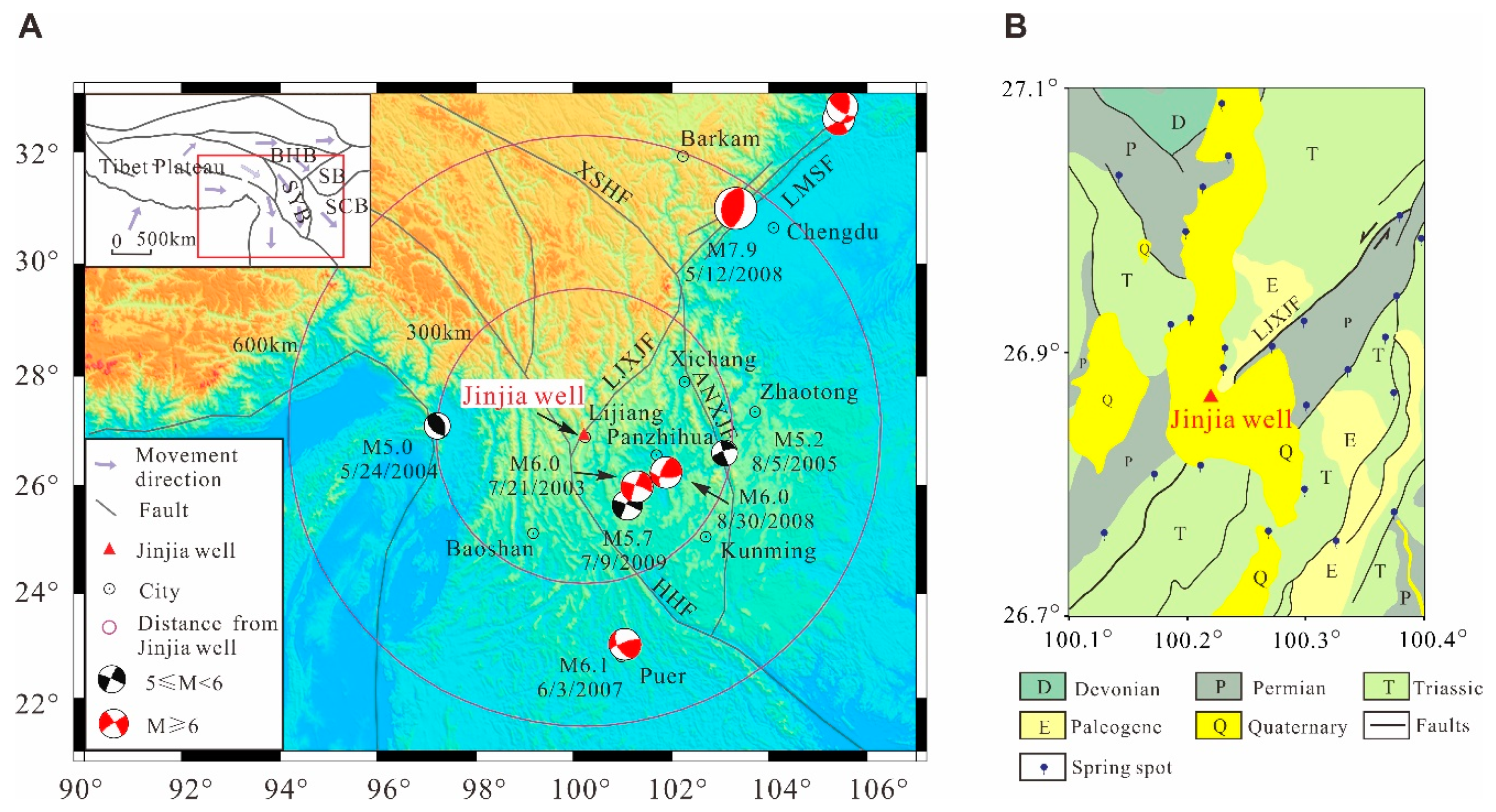

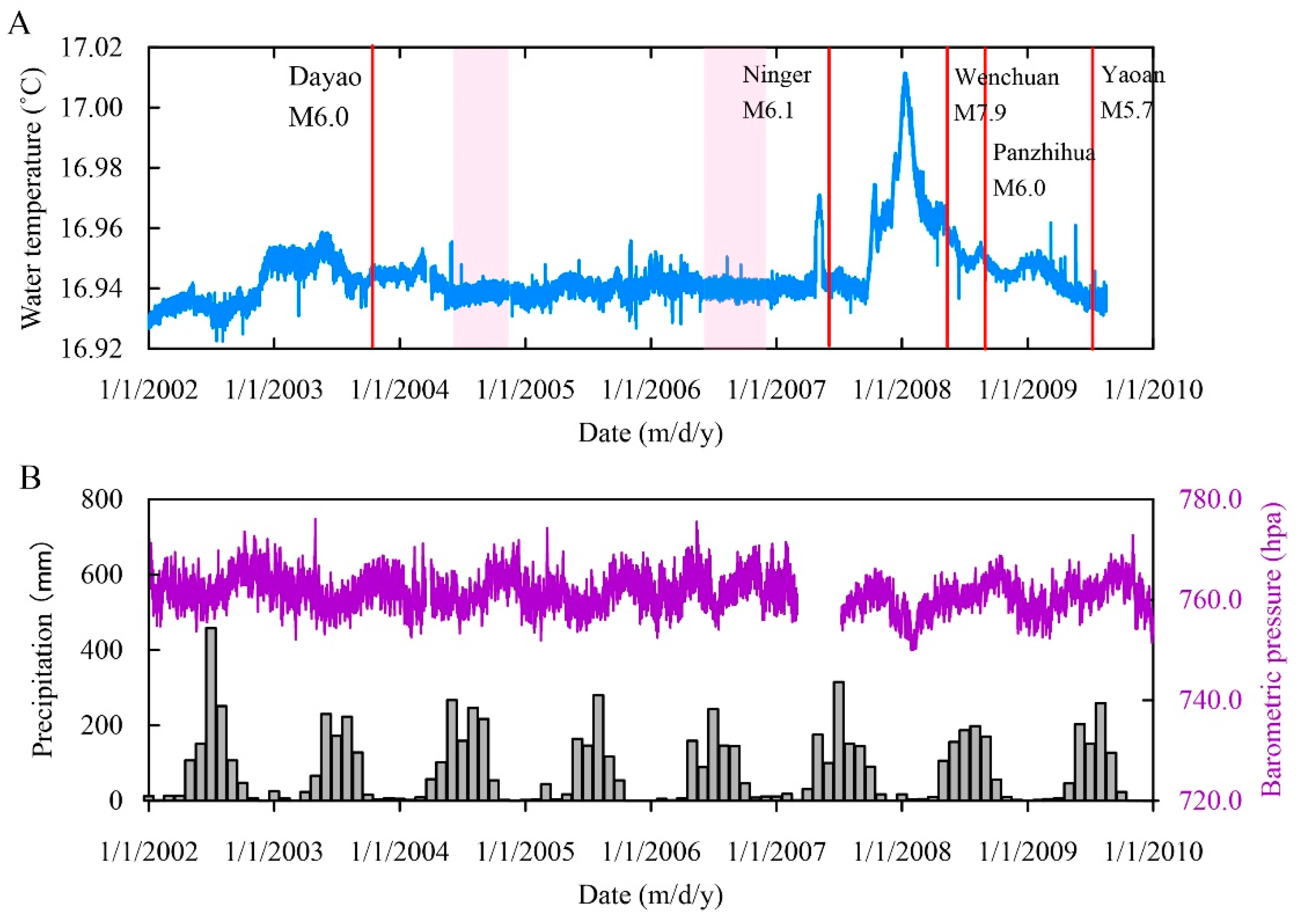

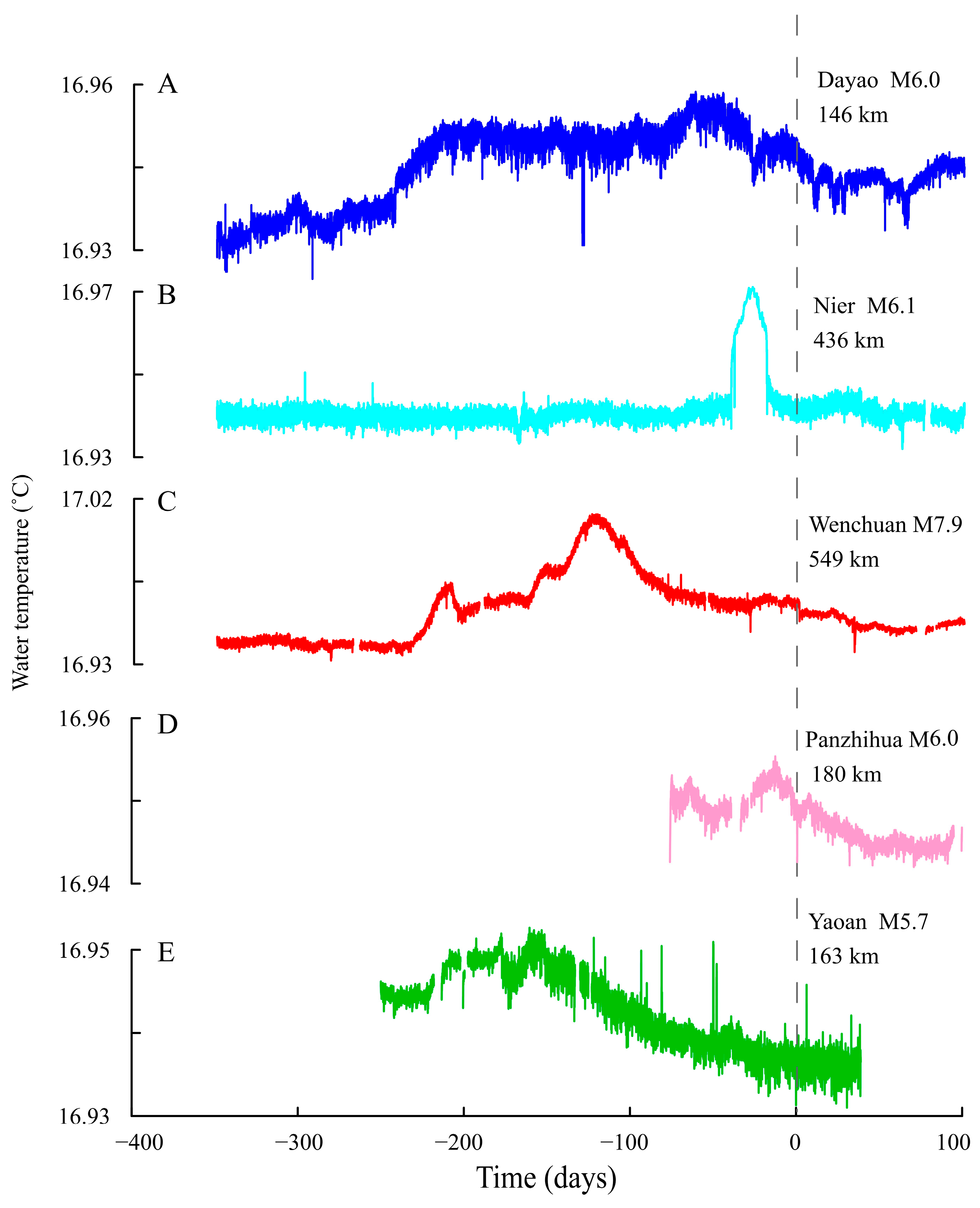
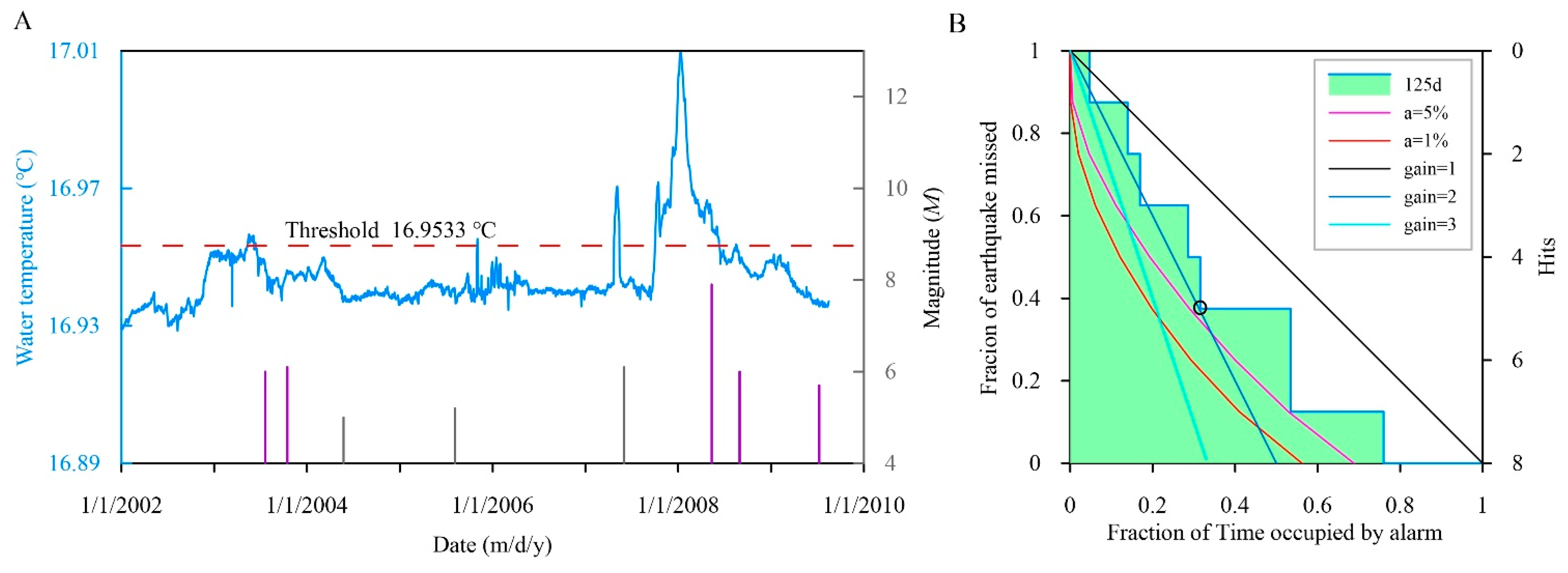

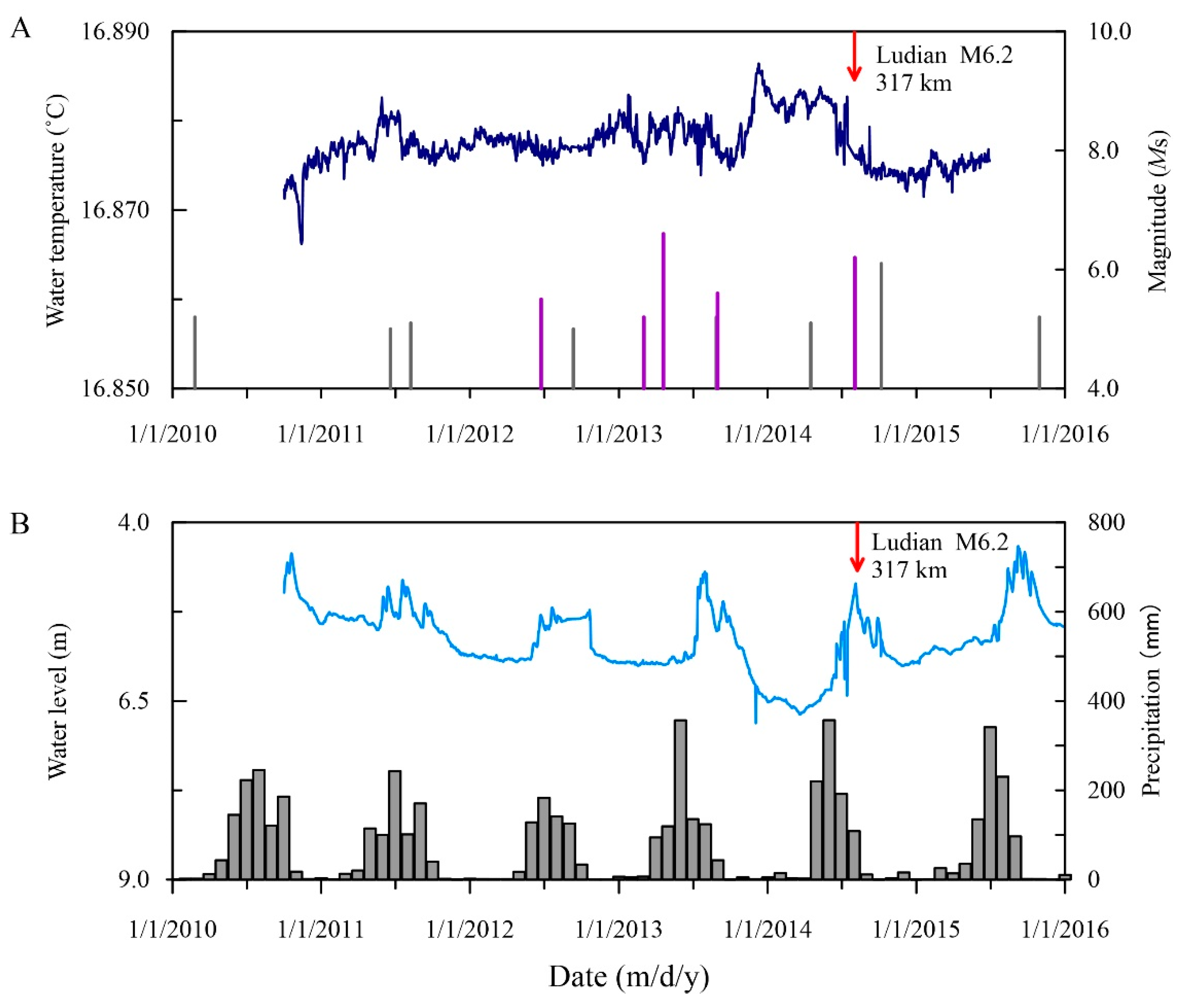
| Date (d/m/y) | Longitude (E°) | latitude (N°) | Magnitude (Mw) | Location | Epicentral Distance, r (km) | e (J·m−3) | Duration (d) | Anomaly (°C) |
|---|---|---|---|---|---|---|---|---|
| 21 July 2003 | 101.29 | 25.98 | 6.0 | Dayao | 146 | 8.4 × 10−3 | 242 | 0.01 |
| 3 June 2007 | 101.05 | 23.03 | 6.1 | Ninger | 436 | 4.3 × 10−4 | 40 | 0.03 |
| 12 May 2008 | 103.32 | 31.00 | 7.9 | Wenchuan | 549 | 8.8 × 10−2 | 231 | 0.07 |
| 30 August 2008 | 101.89 | 26.24 | 6.0 | Panzhihua | 180 | 4.5 × 10−3 | 34 | 0.007 |
| 9 July 2009 | 101.10 | 25.63 | 5.7 | Yaoan | 163 | 2.2 × 10−3 | 222 | 0.016 |
| Observation Station | Earthquake (Year) | Magnitude (M) | Extent of Anomaly (°C) | Type of Anomaly | Duration (d) | Epicentral Distance (km) |
|---|---|---|---|---|---|---|
| spring, Japan a | Izu-Oshima-kinkai (1978) Izu-Hanto-Toho-Oki (1980) | 7.0 6.7 | 1~2 | rising | ~3–300 | 16–31 |
| spa, Japan b | Tohoku in 2011 | 9.0 | 1~2 | declining | ~90 | 155 |
| well, China c | Wenchuan (2008 and others) | 5.0–7.9 | 0.01–0.03 | declining-recovery | 29–127 | 22–690 |
| well, China d | Wenchuan (2008 and others) | 6.0–7.9 | 0.007–0.07 | rising-recovery | 34–242 | 100–560 |
Disclaimer/Publisher’s Note: The statements, opinions and data contained in all publications are solely those of the individual author(s) and contributor(s) and not of MDPI and/or the editor(s). MDPI and/or the editor(s) disclaim responsibility for any injury to people or property resulting from any ideas, methods, instructions or products referred to in the content. |
© 2023 by the authors. Licensee MDPI, Basel, Switzerland. This article is an open access article distributed under the terms and conditions of the Creative Commons Attribution (CC BY) license (https://creativecommons.org/licenses/by/4.0/).
Share and Cite
Yang, Z.; Chen, S.; Liu, Q.; Chen, L. Water Temperature Changes Related to Strong Earthquakes: The Case of the Jinjia Well, Southwest China. Water 2023, 15, 2905. https://doi.org/10.3390/w15162905
Yang Z, Chen S, Liu Q, Chen L. Water Temperature Changes Related to Strong Earthquakes: The Case of the Jinjia Well, Southwest China. Water. 2023; 15(16):2905. https://doi.org/10.3390/w15162905
Chicago/Turabian StyleYang, Zhuzhuan, Shunyun Chen, Qiongying Liu, and Lichun Chen. 2023. "Water Temperature Changes Related to Strong Earthquakes: The Case of the Jinjia Well, Southwest China" Water 15, no. 16: 2905. https://doi.org/10.3390/w15162905





